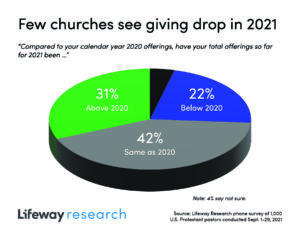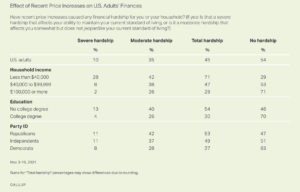With just three Sundays left in the year, it’s once again make-or-break time for most church budgets. And in the second year of the COVID-19 pandemic, amid noteworthy signs of inflation nationally, there are more questions than answers about how church finances will hold up this year.
Whether a church follows the calendar year or some other schedule for its fiscal year, the reality remains that December giving is pivotal for congregational finances. Most American churches take in a disproportionate percentage of their annual income in the last four weeks of the year.
Lifeway Research is the most recent national religion research organization to produce fresh data on church finances, and its polling of Protestant congregations was conducted in September — before inflation worries spiked even higher and before news of the Omicron variant of COVID-19 was widely known.
Most American churches take in a disproportionate percentage of their annual income in the last four weeks of the year.
Based on the attitudes of a representative sample of Protestant pastors across the month of September, Lifeway reported that “most churches don’t seem to be underwater financially, but many are treading water.”
That roughly corresponds to the observations of church consultants queried by Baptist News Global and the informal conversations reported among pastors nationwide. It’s not the best of times for many, but neither is it the worst of times.
“Churches where the financial news is bad, it tends to be really bad,” said Scott McConnell, executive director of Lifeway Research. “Among churches with offerings below 2020, the declines are typically steep, double-digit declines in year-over-year giving. These churches are having to radically rethink their ministry.”
Lifeway found seven in 10 pastors reporting their offering levels this fall were at least meeting budget goals. Almost half (48%) said giving at their church has been about what they budgeted, while 22% said it was trending higher than budgeted. Another 27% said they were not on track to make budget goal this year.
Speaking in general trends, some consultants who work with congregations nationwide note that 2021 presents somewhat different challenges than 2020, the first year of the pandemic and nationwide shutdowns of in-person gatherings.
In 2020, churches may have experienced decreased giving, but they also recorded significantly decreased expenses because programs were canceled and buildings were not being heated, cooled or stocked with supplies. A larger number of Protestant churches also took advantage of the federal Paycheck Protection Program loans that proved to be lifesavers for cashflow in uncertain times.
 There was yet one other important factor that pastors and consultants mention: In 2020, a good number of faithful church members increased their annual giving because they knew the havoc the pandemic was bringing. That included some who used their own federal stimulus checks to make additional church contributions as well as those who turned money not spent on vacations or other projects into extra church gifts.
There was yet one other important factor that pastors and consultants mention: In 2020, a good number of faithful church members increased their annual giving because they knew the havoc the pandemic was bringing. That included some who used their own federal stimulus checks to make additional church contributions as well as those who turned money not spent on vacations or other projects into extra church gifts.
By most expectations, all these unusual factors were one-time things not likely to be repeated in 2021.
One thing pastors and other church leaders know for certain now is the essential nature of online giving. Giving through automatic bank withdrawals, church websites and giving apps already was on the rise in the years leading up to the pandemic, but COVID-19 may have been the death knell for the traditional church offering plate. As churches reopened for in-person worship throughout 2021, many stopped passed a physical offering plate and turned to other methods of promoting giving.
Subsplash is one of several companies that specialize in digital giving platforms specifically for churches. It reports that “online giving is now the No. 1 way people tithe and donate to churches.”
“In 2020, donors gave more to churches through online giving solutions than with cash or checks,” the company reported. “Churches need online giving solutions in order to encourage generosity, increase donations, and reach their budgeting goals. Online giving is no longer a ‘nice-to-have’ option — it’s a necessity.”
Even with digital giving being the new norm, Lifeway research indicates that face-to-face contact will encourage greater giving.
“Mainline and African American churches were slower to resume in-person worship services amid the pandemic,” noted McConnell. “This reduced face-to-face contact appears to have impacted giving in these churches.”
“Most churches are taking a deep breath financially following the uncertainty of the height of the pandemic.”
On the flip side, evangelical churches that reopened more quickly tend to be faring better financially, he added.
But the overall picture remains uncertain and uneven, McConnell said. “Most churches are taking a deep breath financially following the uncertainty of the height of the pandemic. While the official recession ended quickly in April 2020, economic growth has been uneven, and few churches are feeling actual positive impacts from the economy at this point.”
One notable finding from Lifeway’s September polling is that about half (49%) of Protestant pastors said the current economy isn’t having much impact on their congregation — the highest percentage to say this since Lifeway began surveying pastors on this issue in 2009.
At the same time, 12% of Protestant pastors said the economy is having a positive impact on their church, the lowest number since May 2012.
Historically, pastors tend to be negative about the economy’s impact on their congregations. The two years prior to the pandemic, 2018 and 2019, are the only two times in the 12-year history of Lifeway’s survey that more pastors said the economy was having a positive impact than a negative one.
 While inflation is in the daily news, the effects of inflation in America appear to be unevenly distributed, according to new data from Gallup.
While inflation is in the daily news, the effects of inflation in America appear to be unevenly distributed, according to new data from Gallup.
The national polling firm reported this week that 45% of American households say recent price increases are causing their families some degree of financial hardship, with 10% citing severe hardship affecting their standard of living.
Feeling the negative effects of inflation — meaning increased prices for everything from eggs and bread to cars — is most likely to be reported by households with annual incomes of $40,000 or less. Among that group, 71% told Gallup that recent price increases have caused their families financial hardship — more than double the percentage of upper-income households who said the same thing.
That means congregations mainly made up of lower-income worshipers could face greater challenges in year-end giving than congregations with high-income worshipers.
In the broader context, however, charitable giving to religious causes has been growing at a slower pace than giving to other causes, reported David King, director of the Lake Institute on Faith and Giving, in a June article.
“Religious giving … grew 1% this past year, but compared to the overall 5% growth across the charitable sector, religious giving continues to lose market share.”
“Religious giving (narrowly defined as predominantly giving to congregations, denominations, missionary societies, and religious media) grew 1% this past year, but compared to the overall 5% growth across the charitable sector, religious giving continues to lose market share. While still the largest subsector at 28% of total giving, the overall percentage has continued to decline rather drastically over the past few decades.”
And again, the effects of this trend are experienced unevenly, he said. “The challenges of the pandemic highlighted even greater differences between religious organizations. The contrast was not simply due to differences across size, age or ease with technology, but also the openness of the organization to respond to change. When faced with disruption to traditional practices, some organizations met the challenge, developed new capacities, and established new habits and practices. Under a variety of stresses, other organizations did not have the capacity for creativity, resisted change, or simply hoped for the best.”
Based on initial data from faith leaders in 2021, he added, “it appears that, in contrast to last year, many organizations are embracing an openness to prioritizing future-oriented goals. If last year’s first response was simply pivoting and survival, this year, the emphasis has turned toward a capacity for strategic thinking and planning, grounded in mission and purpose, but strongly oriented toward serving needs in the community.”
Related articles:
Despite COVID, ‘worst-case scenario’ did not emerge for church finances
10 reasons we are giving a little extra to the church this year | Opinion by Barry Howard


